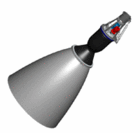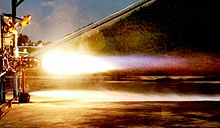


SpaceX Kestrel
| |
| Country of origin | United States |
|---|---|
| First flight | 2006 |
| Last flight | 2009 |
| Designer | Tom Mueller |
| Manufacturer | SpaceX |
| Application | Upper stage boost |
| Liquid-fuel engine | |
| Propellant | LOX / RP-1 |
| Cycle | Pressure fed |
| Performance | |
| Thrust, vacuum | 28 kN (2.9 tf) |
| Thrust-to-weight ratio | 65 |
| Chamber pressure | 9.3 bar (135 psi) |
| Specific impulse, vacuum | 317 seconds (3.11 km/s) |
| Dimensions | |
| Dry mass | 52 kg (115 lb) |
| References | |
| References | [1][2][3] |

The SpaceX Kestrel was an LOX/RP-1 pressure-fed rocket engine. The Kestrel engine was developed in the 2000s by SpaceX for upper stage use on the Falcon 1 rocket. Kestrel is no longer being manufactured; the last flight of Falcon 1 was in 2009.
Kestrel was built around the same pintle architecture as the SpaceX Merlin engine but does not have a turbopump and is fed only by tank pressure.
Kestrel was ablatively cooled in the chamber and throat and radiatively cooled in the nozzle, which was fabricated from a high strength niobium alloy. As a metal, niobium is highly resistant to cracking compared to carbon-carbon. According to SpaceX, an impact from orbital debris or during stage separation might dent the metal but have no meaningful effect on engine performance.[4] Helium pressurant efficiency is substantially increased via a titanium heat exchanger on the ablative/niobium boundary.[5]
Thrust vector control is provided by electro-mechanical actuators on the engine dome for pitch and yaw. Roll control (and attitude control during coast phases) is provided by helium cold gas thrusters.
ATEA-TEB pyrophoric ignition system is used to provide multiple restart capability on the upper stage. In a multi-manifested mission, this design would allow for drop off at different altitudes and inclinations.
Enhancements to the design of the original Kestrel engine were planned, called the Kestrel 2.[6]
The engine design was still pressure-fed, and was supposed to fly on a newly designed second stage that used Aluminium-lithium alloy 2195, rather than the 2014 Aluminum used in the Falcon 1 second stage.[6] Engine changes were to include tighter tolerances to improve consistency, higher Isp, and lighter weight.[7] The Kestrel 2 did not remain in active development after the Falcon 1 was replaced by the much larger Falcon 9 v1.0 which used an improved Merlin 1C for its upper stage.
|
| ||||||||||||||||||
|---|---|---|---|---|---|---|---|---|---|---|---|---|---|---|---|---|---|---|
| ||||||||||||||||||
| Liquid fuel |
|
| ||||||||||||||||
| Solid fuel |
| |||||||||||||||||
| ||||||||||||||||||
|
| ||||||||||
|---|---|---|---|---|---|---|---|---|---|---|
| Launch vehicles |
| |||||||||
| Spacecraft |
| |||||||||
| Test vehicles |
| |||||||||
| Rocket engines |
| |||||||||
| Lists of missions |
| |||||||||
| Launch facilities |
| |||||||||
| Landing sites |
| |||||||||
| Other facilities |
| |||||||||
| Support |
| |||||||||
| Contracts |
| |||||||||
| R&D programs |
| |||||||||
| Key people |
| |||||||||
| Related |
| |||||||||
* denotes unflown vehicles or engines, and future missions or sites. † denotes failed missions, destroyed vehicles, and abandoned sites.
| ||||||||||